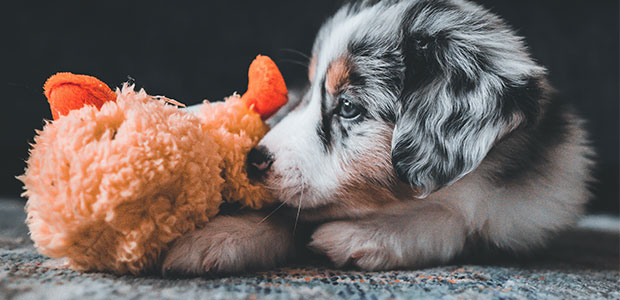Bringing home a new puppy: the ultimate guide
Getting a new puppy is a hugely exciting time.
Welcoming your new, furry family member into your home is step one of your life as an owner.
Let’s look at some top tips for introducing your new pet to their new home. You’ll also find advice on introducing your new puppy to children and existing dogs.
What to do before arrival day?
Before welcoming a new puppy into your home, you’ll need to puppy-proof your home, which will likely involve some shopping! Do you have all the items on our new puppy checklist?
- A bed
- Comfy bedding
- Puppy food (ideally the same as your breeder used, for now)
- Treats
- Toys
- Food bowls
- Water bowls
- Collar
- Lead
- A crate
- Enzymatic cleaner
- Newspaper
Why not ask your breeder if you can take a blanket? To your puppy, this will smell like home and help them feel settled.
Read more: 7 puppy essentials: what do you need for a new puppy?
Bringing home your new puppy: first steps
Try to collect your pup in the morning, this will give them a whole day in their new home before bedtime.
Let them explore each room in turn. Focus mainly on the room they’ll spend most of their time i.e. where their bed, crate, food and water bowls are.
Try not to fuss over your puppy too much during these initial moments, give them plentiful space and time to explore. Pet them if they come to you but otherwise, try to stay calm and quiet while your puppy takes in their new environment.
Once they’ve had a good look around and seem more confident, it’s time to commence with your puppy’s daily routine. Take them out to the toilet, feed them, play with them and make a start on their reward-based training!
Introducing children to your new puppy
Naturally, your children will be excited about getting a new puppy, but it’s important that they remain calm.
Before the initial meeting, speak to your children about how to handle a pet safely. A golden rule is to let the puppy approach them, not the other way around. Try getting them to sit on the floor in a fixed spot while the puppy explores - they’ll approach your children in their own time.
A few more golden rules to teach your children include:
- No pulling the puppy’s hair
- No grabbing the puppy
- No picking them up (unless supervised)
If your puppy goes off to bed, be sure to let them sleep. They’ll naturally be exhausted.
Remember that young puppies may scratch or nip when startled, so calm and careful behaviour will benefit your children as well as their pet.
Read more: Children and pets: introducing a pet to your children.
Introducing a new puppy to your current dog
If your puppy won’t be the only pet at home, introductions will be slightly different.
Step 1:
If your puppy is old enough to go for a walk, it’s a great idea to introduce the two pets outside in a neutral area. I.e. away from the resident dog’s territory! If your puppy is too young for walks, try bringing them into the house while your other dog is out on a walk, following the advice listed above.
Step 2:
Before the resident dog comes home, hide all food, toys and treats - anything they might be defensive over. When you bring them inside, stop in the garden or the lobby; they’ll pick up your new puppy’s scent even though they’re in separated areas.
Next, bring the puppy to see them - keeping them on the lead for now.
Step 3:
As the two pets interact, be sure to reward positive behaviour with verbal praise (forget treats for the time being). Watch them closely and if there’s any tension or negative body language, distract them with a familiar command.
If you have more than one resident pet, it’s best to repeat this process step by step, pet by pet. Don’t panic if this seems like a daunting prospect, your vet will happily advise you.

Feeding time
When it comes to feeding, be sure to feed your puppy separately from your other pets, just until they’re used to each other.
So long as dogs and puppies aren’t competing for food, they should be the best of friends in no time!
And remember…
A few final words of advice:
- Dogs are creatures of habit and learn through association. Help them feel comfortable in their new home with a stable environment and set routine.
- Socialise your puppy with plenty of training. Remember to be patient at all times and to always use positive reinforcement or reward-based methods. Generally, puppies love training - as your puppy grows, why not consider a training class or puppy socialisation party?
- Don’t leave your puppy and older dog alone unsupervised until you’re 100% confident that they’re used to one another. Until then, that’s what your puppy’s stainless steel crate is for!
Need more info?
For more advice on how to introduce a new puppy to your home, have a chat with your local vet. Locate your nearest vet using our Find a Vet page, or speak to a vet online today.


